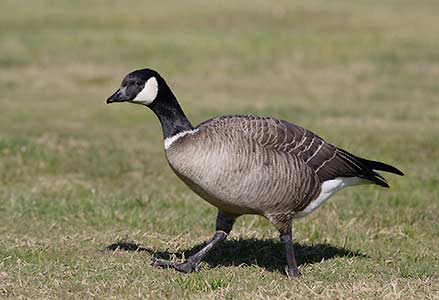
Cackling goose(Branta hutchinsii)
Phylum —chordata
Class — aves
Order — anseriformes
Family — anatidae
Genus – branta
Appearance
Male cackling geese are slightly larger than females, with both sexes having long, black necks with white chinstraps. The breast, abdomen and flanks range in coloring from a light gray to a dark chocolate brown, either blending into the black neck or being separated from it by a wide white collar. The back and scapulars are darker brown, the rump is blackish and the tail is blackish-brown with a U-shaped white band on the rump. The bill, legs and feet are black.
Measurements:
- length: 24.8-25.6 in (63-65 cm);
- weight: 49.3-84.0 oz (1398-2380 g);
- wingspan: 42.5-43.7 in (108-111 cm).
Habitat
This species is native to North America. It breeds in northern Canada and Alaska in a variety of tundra habitats.
Behavior
Like most geese, it is naturally migratory, the wintering range being most of the U.S., and locally in western Canada and northern Mexico. The calls overhead from large groups of cackling geese flying in V-shaped formation signal the transitions into spring and fall. In some areas, migration routes have changed due to changes in habitat and food sources.
Diet
These birds feed mainly on plant material. When feeding in water, they submerge their heads and necks to reach aquatic plants, sometimes tipping forward like a dabbling duck. Flocks of these birds often feed on leftover cultivated grains in fields, especially during migration or in winter. They also eat some insects, mollusks and crustaceans.
Reproduction
The nest is usually located in an elevated area near water. The eggs are laid in a shallow depression lined with plant material and down. Males can be very aggressive in defending territory. A pair may mate for life. Adult geese are often seen leading their goslings in a line with one parent at the front, and the other at the back of the "parade".
Incaptivity
The lifespan of cackling goose in captivity is up to 40 years.
When keeping this species, it is necessary to have a pool with water or a natural reservoir. The optimal ratio of the reservoir area to pasture is 20% water and 80% pasture. In summer, you can put a bathing tub with a minimum size of 1,3x1,3x0,3 m. The bath water will have to be changed as often as possible. Drinking water must be given separately. The enclosure for a couple must be at least 12 sq. m. The optimal height of grass in the pasture is 7.5 cm.
It is necessary to build a poultry house on the territory of the aviary. Geese will be able to hide in it from the cold and wind in the cold season. You need constantly to update the litter in the poultry house. For such bedding, you will need about 40 kg of dry straw (hay). It is important to replace the wet bedding in time. Otherwise, the plumage quickly becomes dirty and does not protect the bird from the cold.
The poultry house should be made of wood or mud. Humidity and drafts are not allowed in it. In the door for the staff, or directly in the wall of the poultry house, you need to cut one or two gate holes for birds. It is necessary to maintain a constant temperature of 0-2°C in the poultry house. Infrared lamps and electric oil heaters are suitable as heaters. Infrared lamps should be hung at a height of 1.5 m, electric fireplaces should be installed in front of the loopholes to block access to cold air. As a rule, the exits are not closed (except on very cold days and nights), so that the birds can freely walk from the enclosure to the room and back. In the center of the poultry house, you need to install a drinking bowl with electric heating, so that the water in it does not freeze even when the heaters are turned off. The room must be illuminated during the day with two incandescent lamps with a total power of 150 watts.
During the construction of a poultry house, it is very important to take into account that at least one square meter of floor space should be allocated for one adult goose. With a higher density, the room will quickly become polluted, and the air in it will stagnate. This can cause diseases of wild geese and significantly reduce their productivity. Once a year, you need to whitewash the walls with freshly slaked lime.
Aviaries of all types must be equipped with feeders, because green food on the ground is quickly trampled by the geese. This is also convenient from the point of view that birds can easily choose their favorite plants from all the abundance of various grasses with a large width of the feeder.
Geese eat natural grasses. You can add to herbs: wheat grains, waterfowl pellets, and chicken feed. If there is not enough grass on the pasture, it is necessary to bring mown fresh grass. In winter, you can feed sliced vegetables, especially good to give cabbage and salads. Not averse to eating worms, insects and shellfish sometimes.
During nesting, males often become aggressive, so it is better to separate the nesting couple from other birds.
 Russian
Russian
 English
English
























